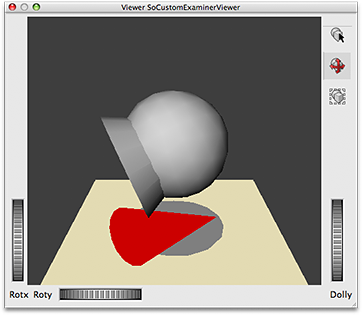SoShadowMaterial¶
-
InventorModule¶ genre Visualizationauthor Felix Ritterpackage FMEwork/ReleaseMeVisdll SoShadowdefinition SoShadow.def see also SoShadowCast,SoPickableShadowCast,SoShadowSwitch,SoShadowAwareTransformerManipkeywords shadow,material,viewer,illustration,visualization
Purpose¶
The SoShadowMaterial module may be used to give individual objects a distinct shadow color.
See: Illustrative Shadows: Integrating 3D and 2D Information Displays. Felix Ritter, Henry Sonnet, Knut Hartmann, and Thomas Strothotte. Proceedings of ACM Intelligent User Interfaces 2003, pp. 166-173.

Usage¶
Connect the SoShadowMaterial module to the scenegraph preceding shapes whose shadow color should be modified.
Details¶
You may also use the module to change nonshadow material parameters.
Output Fields¶
Parameter Fields¶
Field Index¶
Ambient Color: String |
Transparency: String |
Diffuse Color: String |
Use Shadow Color: Bool |
Emissive Color: String |
|
Override Render Pass: Enum |
|
Shadow Color: String |
|
Shadow Offset: Vector2 |
|
Shininess: String |
|
Specular Color: String |
Visible Fields¶
Ambient Color¶
-
name:ambientColor, type:String, default:0.2 0.2 0.2¶ Ambient color of the surface.
Diffuse Color¶
-
name:diffuseColor, type:String, default:0.8 0.8 0.8¶ Diffuse color(s) of the surface.
Shininess¶
-
name:shininess, type:String, default:0.2¶ Shininess coefficient of the surface. Values can range from 0.0 for no shininess (a diffuse surface) to 1.0 for maximum shininess (a highly polished surface).
Transparency¶
-
name:transparency, type:String, default:0¶ Transparency value(s) of the surface. Values can range from 0.0 for opaque surfaces to 1.0 for completely transparent surfaces.
Use Shadow Color¶
-
name:useShadowColor, type:Bool, default:TRUE¶ If enabled, the given shadow color will be used.
Shadow Color¶
-
name:shadowColor, type:String, default:0.65 0.62 0.51¶ Determines the color of the shadow.
Shadow Offset¶
-
name:shadowOffset, type:Vector2, default:0 0¶ If not ignored (ignored by default), this field can be used to explicitly define how individual shadows should be offset with regard to other shadows.The first component specifies a scale factor that is used to create a variable depth offset for each polygon. The second component is multiplied by an implementation-specific value to create a constant depth offset. See SoPolygonOffset.